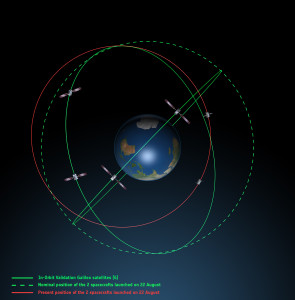
This illustration, released by the ESA, shows the erroneous satellite orbit in red, and the intended orbit in dashed green. The other two lines represent current Galileo satellite orbits
Nearly two months after the two Galileo satellites were deployed into an erroneous orbit nearly 2,000 miles off course, an independent inquiry board investigating the cause has finally determined the reasons for the mistake and outlined solutions to prevent further mishaps.
Last week, it was reported that a frozen pipe was to blame for the mishap, but official comments from the inquiry board had not been released. GPS World reported yesterday that the board had determined that the anomaly was not caused by an operator error or by satellite behavior, but by a design flaw in the rocket.
Apparently, the failure stemmed from the freezing of the hydrazine fuel, which is used during the Fregat stage, where the satellites are moved into their intended position. The fuel froze because the pipeline was next to a cold helium feed line, and caused various malfunctions and interruptions which stranded the satellites in an unusable orbit.
The board said that this design flaw has been present in various other Fregat stages, including lines currently under production. Corrections have been made to the design documents, and the future Fregat stages will be redesigned and tested to ensure that such errors don’t happen again. It is worth noting that despite this design, the article reported there have been 45 successful consecutive missions with this Fregat design.
From what it sounds like, the scheduled December launches for additional Galileo satellites will proceed as planned, provided that the corrections to the Fregat stage are completed in time.
The Galileo system will be the first civilian operated GPS system, created by the European Union. There are currently four operational Galileo satellites in orbit, plus the two stray satellites. The December launch initially was planned to complete the first stage of the constellation, but this will likely be pushed back by a year with this most recent problem.
To get updates on the Galileo satellites or to read more about their mission and plans, check out the ESA website.
